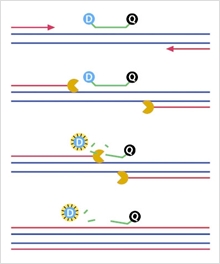PrimeTimeЂч qPCR 5' Nuclease Assays
Primer, Probe mix
Real-Time PCR РЛ РЇЧб ProbeПЭ 2АГРЧ PCR primersИІ Чб tubeПЁ ДуОЦМ СІАјЧеДЯДй.
•• 5' reporter dyeЗЮ FAM, HEX, TET, Cy5, TAMRA АЁДЩ
•• 100% QC
•• 5-7РЯ ОШПЁ ЛчПыЧЯБт ЦэЧб single tubeПЁ АјБо
•• PCRРЛ РЇЧб УжРћШ; ideal for many life science research applications
•• СІЧААњ ЧдВВ sequence informationРЬ РжДТ Specification sheet АЁ СІАј
•• IDTПЁМ РдСѕЕШ Real-Time PCR Design ToolРЛ ХыЧб Е№РкРЮ
PrimeTime qPCR assaysДТ ММ АЁСі ЛчРЬСюЗЮ АјБоЕЫДЯДй. primers ПЭ probeАЁ premixed ЕЧОю Чб tubeПЁ ДуОЦМ lyophilized ЧќХТЗЮ АјБоЕЧИч 500 nMРЧ primer ПЭ 250 nM РЧ probeИІ ЙнРРНУ ИэНУЕШ ЛчПыЗЎРЛ УцКаШї РЬПыЧЯНЧ Мі РжНРДЯДй. СжЙЎЧЯНУИщ Ор 1СжРЯИИПЁ ЙоОЦКИНЧ Мі РжРИНУ Ич ДйИЅ ШИЛчПЭ ДоИЎ И№Еч ПУИЎАэПЁ ДыЧиМ 100% QC АЁ РЬЗчОюСіАд ЕЫДЯДй.
СІЧА БИМК
|
No. of Reactions
(20 ЅьL) |
Price
(FAM-ZEN/Iowa Black FQ) |
Price
(other dye-quencher combinations) |
Estimated Ship Date |
Probe (nmoles) |
Primers (nmoles)2 |
| PrimeTimeЂч Mini qPCR Assay |
100 |
(FAM,SUN)
|
(HEX, Cy5)
|
1 СжРЯ |
0.5 |
1.0 |
| PrimeTimeЂт Standard qPCR Assay |
500 |
(FAM,SUN)
|
(HEX, TET, CY5)
|
1 СжРЯ |
2.5 |
2.5-10 |
| PrimeTimeЂч XL qPCR Assay |
2500 |
(FAM,SUN)
|
(HEX, TET, CY5)
|
1 СжРЯ |
12.5 |
12.5-50 |
|
Product ID |
Product |
|
|
Eco-HEX |
PrimeTime Eco Probe 5' HEX / ZEN
/ 3' IBЂчFQ |
|
|
Mini-HEX |
PrimeTime Mini Probe 5' HEX / ZEN / 3' IBЂчFQ |
|
|
Eco-Cy5 |
PrimeTime Eco Probe 5' Cy5 / TAO
/ 3' IBЂчRQ |
|
|
Mini-Cy5 |
PrimeTime Mini Probe 5' Cy5 / TAO / 3' IBЂчRQ |
|
|
52029 |
Affinity PlusЂч Mini Probe 5' SUN / 3' IBЂчFQ |
|
|
52032 |
PrimeTime Eco Probe 5' SUN / ZEN
/ 3' IBЂчFQ |
|
|
52041 |
PrimeTime Mini Probe 5' SUN /
ZEN / 3' IBЂчFQ |
|
|
52028 |
Affinity PlusЂч Mini Probe 5' Cy5 / 3' IBЂчFQ |
|
PrimeTimeЂч qPCR 5' Nuclease AssaysПЁ АЁДЩЧб Reporter ПЭ Quencher СЖЧе
|
5' Dye |
3' Quencher |
Mini |
Standard |
XL |
|
FAM |
ZEN/Iowa Black FQ* |
• |
• |
• |
|
FAM |
TAMRA |
|
• |
• |
|
HEX |
ZEN/Iowa Black FQ* |
|
• |
• |
|
TET |
ZEN/Iowa Black FQ* |
|
• |
• |
|
Cy5 |
Iowa Black RQ |
|
• |
• |
Pre-designed PrimeTimeЂч qPCR Assay
* 100 % АсАњ КИРх (positiveПЭ negative control ЕЅРЬХЭ СІАј НУ)
* Sequence СІАј (СІЧААњ ЕПКР)
* Human, mouse, rat ММ АЁСі speciesПЁМИИ Е№РкРЮ СІАј
Pre-designed PrimeTimeЂч qPCR AssayДТ
ОЦЗЁ ИЕХЉПЁМ Е№РкРЮРЛ СїСЂ Чв Мі РжНРДЯДй.
Overview of 5ЁЧ Nuclease Assays
Step 1—The primers and probe hybridize in a sequence-dependent manner to the complementary DNA strand. Because the probe is intact, the fluorophore and quencher are in close proximity and the quencher absorbs fluorescence emitted by the fluorophore.
Step 2—The polymerase extends from the primers and begins DNA synthesis.
Step 3—The polymerase reaches the probe and the exonuclease activity of the polymerase cleaves the hybridized probe. As a result of cleavage, the fluorophore is separated from the quencher and fluoresces.
Step 4—The fluorescence is detected by the real time instrument.
These steps are repeated for each PCR cycle and allow detection of specific products. With intercalating dyes, such as SYBRЂч Green I, primer-dimers and non-specific products will also contribute to fluorescence. In contrast, the 5ЁЏ Nuclease assay is specific and fluorescence will only be detected for the DNA sequence to which the probe and primers hybridize.
Selecting the Correct Reporter Dye and Quencher
Reporter Dyes
The correct reporter dye will depend on the type of instrument you are using and the compatibility of the dye with the instrument. Please see the
Instrument Compatibility Table for a list of reporter dyes compatible with common instrumentation.
Quenchers
Traditional dark quenchers absorb broadly and do not emit light which allows for the use of multiple reporter dyes with a given quencher. This characteristic allows for expanded options for multiplex assays. Dark quenchers simplify detection which makes them compatible with a broad range of image analysis instruments.
IDT has developed an internal ZEN quencher that enables to production of Double-Quenched Probes which have less background and more signal. The Double-Quenched Probes contain a 5ЁЏ FAM fluorophore, a 3ЁЏ IBFQ quencher, and an internal ZEN quencher. These Double-Quenched Probes are an improvement over traditional dual-labeled probes and have consistently low background, reduced C
q values, improved precision, and enable the use of longer probes for design in AT-rich regions. For more information download the
ZEN Double-Quenched Probe Overview.
IDT supplies commonly used dark quenchers as well as the proprietary dark quenchers, Iowa Black FQ, Iowa Black RQ, and the newly developed internal ZEN quencher. TAMRA is also a quencher option for a FAM reporter dye. Related Information
 IDT
IDT
